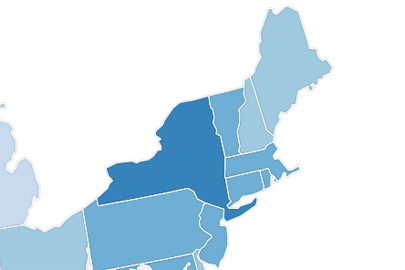Will a small number of Jewish voters tip this presidential election?
A team of Brandeis researchers has examined the role the Jewish vote might play in swing states on Election Day.
 Photo/Steinhardt Social Research Institute
Photo/Steinhardt Social Research InstituteScholars at Brandeis University’s Steinhardt Social Research Institute have just unveiled their latest county-level estimates of the American Jewish population, which includes the first-ever look at the political leanings of the population in county-by-county comparisons with the general population.
The study – also known as the American Jewish Population Project – provides an in-depth, county-by-county look at what the American Jewish community looks like in terms of its race and ethnicity, and education level.
“The Jewish population in the US is considered a ‘rare’ group; it’s roughly two percent of the whole country,” said Research Scientist Elizabeth Tighe, who collaborated with Research Associates Raquel Magidin de Kramer and Daniel Parmer on the project. “If you try to get a nationally representative sample of a rare group, it’s hard to do.”
The study, initiated in 2005 by professor Leonard Saxe, the director of the Cohen Center for Modern Jewish Studies and the Steinhardt Social Research Institute, synthesizes hundreds of surveys and polls of the US adult population.
The new estimates are based on more than 250 surveys conducted from 2008 to 2015. On September 22, the study, which now includes an entire team of researchers, was re-launched with a new site as well as with an interactive map.
The study estimates that the total U.S. Jewish population is 7.1 million. This number includes both those who identify their religion as Judaism, as well as those who consider themselves Jewish because their backgrounds. According to Saxe, after a period of slow growth, the American Jewish population is increasing at a rate similar to the overall population.
“In surveys, most Jews will say they are Jewish by religion, but there are a lot that fall through the cracks,” Tighe said. “You have to look at other surveys or follow-up questions that ask people about how they identify culturally and ethnically.
“Through data synthesis, we’re able to look at multiple independent samples and standardize across them to arrive at better estimate of ‘the truth’, than can be done in a single one-shot study.” Tighe added. “You need to look at repeated samples to get a true sense of the Jewish population.”
Meanwhile, the American Jewish Population Project also found that roughly half of the Jewish population lives in three states: New York, California and Florida.
This information has implications for the approaching Presidential election as well.
For instance, there is a sizeable contingent of Jews who live in swing states across the country, which means their votes on November 8 could play a key role in determining the final look of the Electoral College map.
“We’ve actually gone from looking at swing states to swing counties,” said Tighe.
Tighe and Parmer pointed out that Jewish make up 15 percent of the adult population in Palm Beach, Florida, which is significant since President Barack Obama won the state by just one percent in 2012. Jews also make up six percent of the adult population in the Bucks County and Montgomery County in Pennsylvania.
As of now, Presidential candidates Hillary Clinton and Donald Trump are neck and neck in both swing states, according to the latest polls.
That’s why the study’s ability to decipher the political leanings of Jews is so significant.

The American Jewish Population Project found that 54 percent of American Jews identify as Democrats, while 14 percent identify as Republicans, even though only 43 percent of American Jews call themselves liberal, a lower percentage than those who say they are Democrats.
“Might the Jewish vote be enough to sway an election?” Parmer asked. “Jews are more likely than other groups to be registered and vote. This study helps us see what the impact of the Jewish vote might be.”





